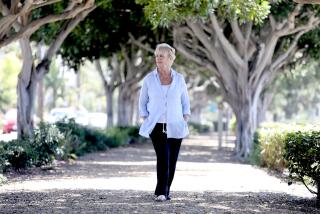Child Seat Law to Get Stricter
When Californiaâs new child car seat law goes into effect on Jan. 1, Maria Iraheta will need to buy not only a second car seat, but also a bigger vehicle.
Sheâs managed to squeeze her 4-year-old sonâs child safety seat into her tiny Chevy truck. But now that her 5-year-old daughter will have to start using a safety seat again, sheâs in a quandary about what to do.
âThereâs not enough space in my truck to put another car seat. We can buy another car seat, but we donât have the money to change cars,â said Iraheta of North Hills, a baby-sitter whose husband works as a gardener.
Iraheta is not alone in facing a New Yearâs dilemma. A more stringent child seat law is undoubtedly safer but it may be costly, inconvenient and difficult for parents--particularly those whose children have âgraduatedâ to standard seat belts.
Current law requires children to ride in a car seat or booster seat that meets federal safety standards until they are at least 4 years old and weigh at least 40 pounds. As of Jan. 1, the law will require children to use such devices until they are at least 6 years old or weigh at least 60 pounds.
Scofflaws will be hit harder too. First-offense fines jump from $50 to $100; second offenses from $100 to $250. Last year in California, 9,398 tickets were written for safety seat violations, a number that is expected to rise in 2002.
Law enforcement officials and child safety advocates say the change is overdue, since motor vehicle crashes are the leading cause of unintentional injury-related deaths nationwide, annually killing nearly 1,800 children 14 and younger and injuring more than 274,000 others.
Nationwide, only 5% of 4- to 8-year-olds ride in booster seats, according to the National SAFE KIDS Campaign. About 30% of American children ride unrestrained and, of those who are buckled up, four out of five are improperly restrained.
Safety seats protect childrenâs fragile bodies better than seat belts alone, safety experts say. Booster seats help bigger children ride high enough so that seat belts restrain them around the shoulder and chest, instead of riding up on the neck or head.
Indeed, a 4-year-old girl was killed and her 1-year-old sister critically injured this month when the car their mother was driving hit a tree in Northridge. If the older child had been in a safety seat, instead of using a seat belt that was tucked under her arm, the outcome might have been different, said LAPD Officer Norm Kellems, one of the few law enforcement officials in the state who is a child passenger safety instructor.
The California Highway Patrol considers the stricter law so important that it secured a $525,000 federal grant to buy commercials on English- and Spanish-language radio stations during commute hours to publicize the change, said CHP spokesman Steve Kohler. Free public service announcements, in contrast, might have been broadcast only in the middle of the night.
Other law enforcement agencies will join the effort to publicize the new law.
Los Angeles Police Department officers will inform parents of the new law at checkpoints set up to catch those who arenât buckled up. Some Los Angeles County Sheriffâs Department stations plan to distribute letters on the subject for children to take home from school.
Though many parents support the new law, that doesnât necessarily make it easy for them to do the right thing. First there is the cost, about $23 to $80 for a booster seat.
âItâs good for the safety of the child, but some people donât have the money to buy one,â said Ena Arevalo of North Hills, who will need a booster seat for her 4-year-old daughter.
Part of each fine for a safety-seat violation goes into a Los Angeles County Health Department program to help low-income families get car seats. For six years, the county has awarded 2,500 vouchers, worth $45 each, toward car seats to parents who attend safety classes.
In addition, the Ford Motor Co. will be giving the county about 5,000 booster seats that will be distributed to low-income families at community events and county hospitals and health centers, said Voncille McKinney, program manager of the countyâs child passenger safety restraint program. For more information, call (213) 351-5224.
Beyond cost, other parents wonder how they will be able to cram in all the kids in their carpool, if all must ride in safety seats. Others fret about how they will persuade car seat-liberated children that itâs not a bad thing to return to the restrictive devices.
Five-year-old Joey Paul of Agoura Hills, the youngest of six, always rides in a car seat when heâs with his mother. But with Dad, he uses a conventional seat belt, said his mother, Elizabeth, who plans to buy a booster seat for her husbandâs car.
âItâs a point of contention,â she said, âbut [my husband] will come around because there will be a permanent car seat in his car. Itâs the right thing to do. Itâs the safest thing to do.â
Debra Ozolnieks, whose 5-year-old son Devyn stopped using a safety seat a year ago, would rather see stronger enforcement of the existing car seat law.
âI hate the idea of it. It feels like a regression,â said the Agoura Hills mother.
Devyn, however, thinks it will be good to use a car seat again--not so much for safety, but so he can see more. âI want to be higher,â he said.
So, how will parents get older kids back into a car seat?
Try making it into a new rite of passage by saying, âYouâre ready for a booster seat now!â suggests CHP spokesman Kohler. âDonât parents deal with that all the time: making sure your child does all the things theyâre supposed to do? You can do it in a way that persuades the child without being too traumatic.â
Safety experts look forward to a day when consumers will not look on child safety seats as an onerous government mandate. Stephanie M. Tombrello, executive director of SafetyBeltSafe U.S.A., said thereâs a need for âa new social climateâ to change perceptions. The groupâs âBoosters Are for Big Kidsâ curriculum for kindergarten through third-grade students tries to take a step in that direction.
Tombrello suggests that parents look at car seats as a long-term commitment, even buying devices that their children will be comfortable in until they are 8, or even 10.
âUnfortunately, [the new law] is not enough,â said LAPD Officer Kellems. âMany parents go by the letter of the law, and as soon as [their children] turned 4, they took them out of their car seat. Now, as soon as they turn 6, they will take them out of their car seat.
âMy advice is, if they do what is safe for their child, they will be doing more than the law requires.â
*
If you have questions, comments or story ideas regarding driving or traffic in Southern California, send an e-mail to [email protected].
More to Read
Sign up for Essential California
The most important California stories and recommendations in your inbox every morning.
You may occasionally receive promotional content from the Los Angeles Times.



![[20060326 (LA/A20) -- STATING THE CASE: Marchers organized by unions, religious organizations and immigrants rights groups carry signs and chant in downtown L.A. "People are really upset that all the work they do, everything that they give to this nation, is ignored," said Angelica Salas of the Coalition of Humane Immigrant Rights. -- PHOTOGRAPHER: Photographs by Gina Ferazzi The Los Angeles Times] *** [Ferazzi, Gina -- - 109170.ME.0325.rights.12.GMF- Gina Ferazzi/Los Angeles Times - Thousands of protesters march to city hall in downtown Los Angeles Saturday, March 25, 2006. They are protesting against House-passed HR 4437, an anti-immigration bill that opponents say will criminalize millions of immigrant families and anyone who comes into contact with them.]](https://ca-times.brightspotcdn.com/dims4/default/34f403d/2147483647/strip/true/crop/1983x1322+109+0/resize/840x560!/quality/75/?url=https%3A%2F%2Fcalifornia-times-brightspot.s3.amazonaws.com%2Fzbk%2Fdamlat_images%2FLA%2FLA_PHOTO_ARCHIVE%2FSDOCS%2854%29%2Fkx3lslnc.JPG)






